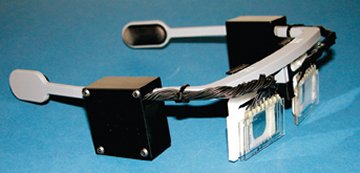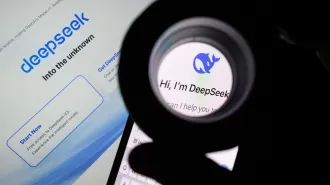A new type of eyeglasses with electrically adjustable focus might someday render bifocals and reading glasses obsolete, the device’s inventors say. So far, the researchers have made a battery-powered prototype with close-up focus that flicks on and off with a switch.

Future versions of the eyeglasses may incorporate a distance sensor to automatically adjust the focus as the viewer’s gaze changes between far and near viewing, says one of the inventors, electrical engineer David L. Mathine of the University of Arizona in Tucson.
Most people by their late 40s can no longer focus on close objects. This visual defect is known as presbyopia. The company PixelOptics of Roanoke, Va., plans to create a commercial version of the electrically adjusted eyeglasses to market to presbyopic people, who typically wear bifocals, trifocals, or graded lenses. Worldwide, about 50 million people per year become presbyopic, according to the company’s Web site.
In bifocals, some portion of the lens remains unfocused for the distance of interest at any given time, notes Mathine. In the new eyeglasses, the entire lens switches to the desired focus. For close vision, for instance, “you don’t have just the bottom half of your eyeglasses. You get the whole view,” he says.
To make eyeglass lenses that change focus electrically, the researchers created sandwiches of glass sheets separated by a fluid layer 5 micrometers thick. The filling consists of a transparent substance, a type of liquid crystal, that’s made up of rod-shaped molecules suspended in a liquid (SN: 12/20&27/03, p. 388: Available to subscribers at Crystal Clear: Liquid crystal sensor plays nature’s game). The team used precise computer-chip–manufacturing methods to apply a bull’s-eye pattern of transparent electrodes to the inner surface of one of the glass sheets.
In response to voltages applied to those electrodes, the liquid-crystal rods rotate into new orientations, explains Guoqiang Li of the University of Arizona and a member of the development team. The rod orientation determines the speed at which light passes through the liquid-crystal layer. Light rays bend as they traverse the layer and so can become focused, much as they would when passing through an ordinary lens.
The researchers describe the new eyeglasses in the April 18 Proceedings of the National Academy of Sciences.
In the past, other scientists have made electrically controlled lenses from liquid crystals—using them, for instance, to steer laser beams or to alter the focus of a reader used in optical-memory devices. However, previous liquid-crystal lenses could neither focus well enough nor change their focus quickly enough for use in eyeglasses, Li says.
The newly developed lens is “the only adaptive lens that is practical for presbyopia patients,” says biomedical and optical engineer Shuliang Jiao of the University of Miami (Fla.) School of Medicine, who didn’t participate in the research.
PixelOptics plans to create a version of the glasses that will enable people to have better than normal 20/20 vision, says physicist Dwight P. Duston, head of research and development for the company.





